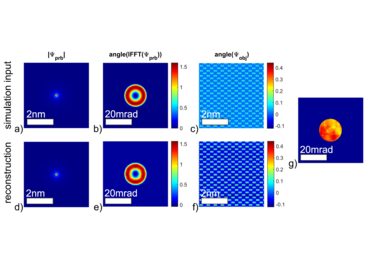Christoph Mahr, Knut Müller-Caspary, Tim Grieb, Florian F. Krause, Marco Schowalter, Andreas Rosenauer
Ultramicroscopy (2021) 221, 113196
https://doi.org/10.1016/j.ultramic.2020.113196
Strain analysis by nano-beam electron diffraction allows for measurements of strain with nanometre resolution in a large field of view. This is done by evaluating distances between diffraction discs in diffraction patterns acquired while a focussed electron beam is scanned across the sample in a transmission electron microscope. The bottleneck of this method is a precise determination of diffraction disc positions, which suffers from the inner structure of the discs caused by dynamical diffraction. Electron beam precession is a tool that solves this problem but it is not commonly available in every microscope. Without precession significant progress has been reported recently by using patterned condenser apertures. The pattern of the aperture is reproduced in patterns of the diffraction discs allowing for a more precise position determination. In this report the accuracy of measured strain profiles using patterned apertures is investigated by evaluation of realistic simulations. This is done especially at interfaces between regions with different lattice plane spacing. It is found by evaluation of the simulations that measured strain profiles are more blurred and hence the accuracy at the interface is worse the more patterns are imprinted to the condenser aperture. An explanation of this effect is given and as a proof of principle a solution to this problem is provided applying geometric phase analysis ptychography.


